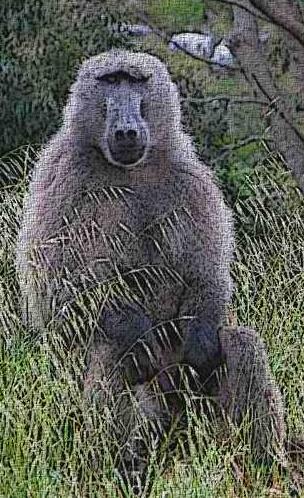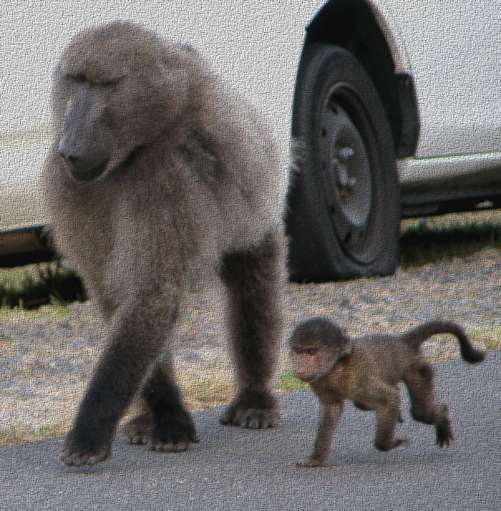
Females and infant
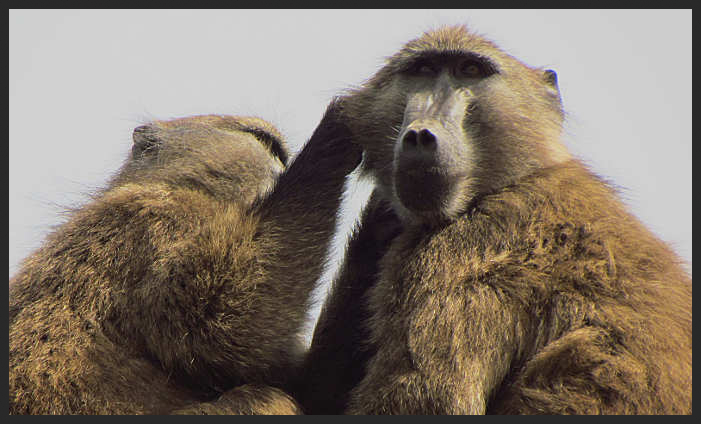
A male baboon enjoys being groomed by a female. Grooming removes parasites but also helps consolidate social bonds.
26 March 2015
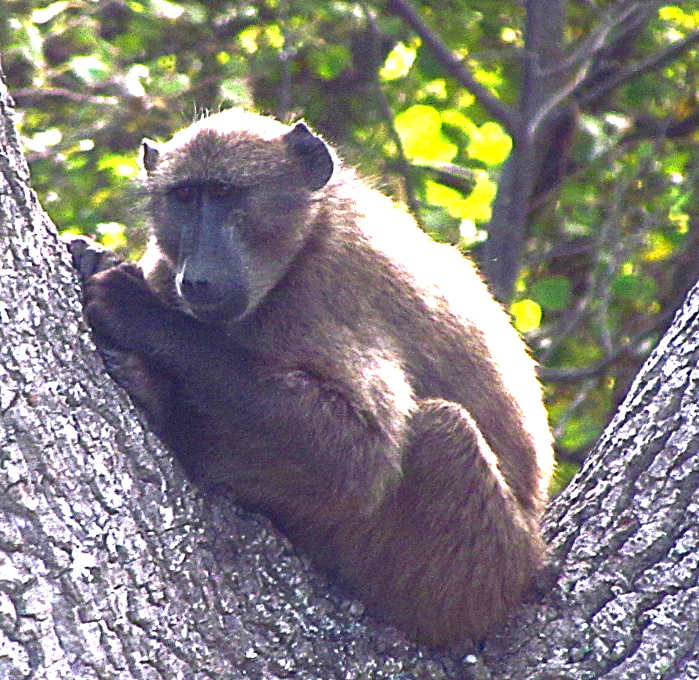

As sub-adult male sits in a tree unaffected by fire, a Da Gama Park female stands on burnt area.
Over the weekend of 21/22 March 2015 a fire was started in Da Gama Park, brought under control by firefighters. It was one of the thousands of fires that have occurred over the summer months of 2014/2015. March saw the big fire that started in Muizenberg on 1 March 2015 raze around 6000 hectares of vegetation.
The Northern troops, and especially the Tokai troop were the most affected. To date, 12 troop members have died. The troop's foraging was also severely affected, much of their home range described as a "lunar landscape".
Regarding an increase of fire incidents, on Monday 2 March, 2015, Cape Town Mayor Patricia de Lille was reported by Business Day LIve as saying "Our latest recorded statistics revealed that there had been an increase from 3,359 incidents between December 2013 and January 2014, to 4,325 incidents during the same period this festive season. "
The causes of the March fires are being investigated by forensic investigators, including forensic scientist, Dr David Klatzow.
UPDATE - September 2014
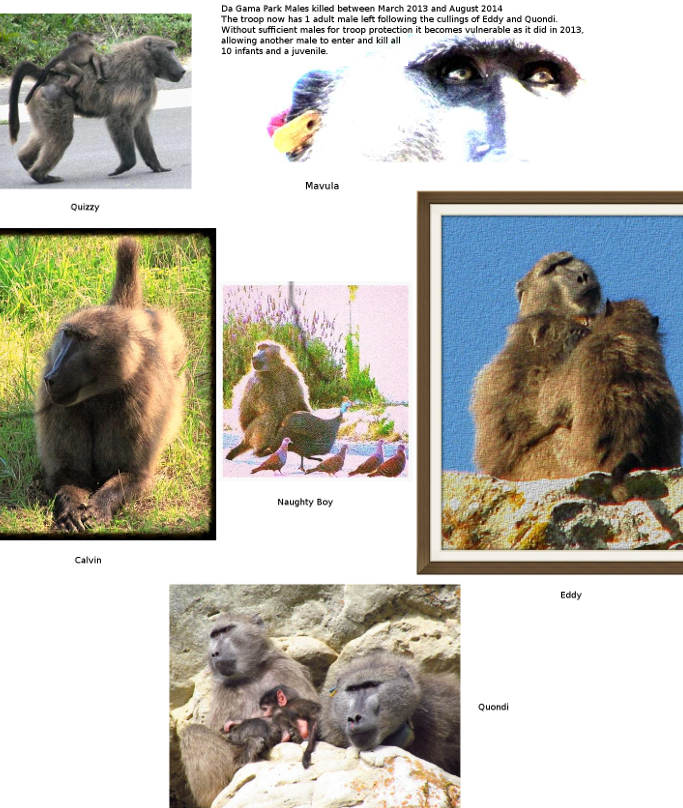
How the Da Gama Park adult male and maturing male baboons have "disappeared" since 2013
Quizzy - when the troop was held in an area known as best avoided by the baboons due to dogs, he was attacked by humans and dogs and decision taken to put him down in March 2013.
Mavula - was nevertheless culled later in March 2013, leaving only Quondi as adult male, creating the opportunity for Woody a male from Slangkop to enter and kill 10 infants and a juvenile, also causing a great deal of stress for the rest of the troop. (Woody, was later culled in terms of the dispersing male protocol.) The main Da Gama troop and fission troop were pushed together and Horace, also from Slangkop, who had entered the fission troop after the culling of Peter and Carpenter in August and September 2012 in ongoing failed attemptsto merge the two troops, was claimed to be the new alpha, although Quondi, the longtime alpha male, continued to play a cohesive role.
Calvin - culled 1 October 2013, was being chased by Horace and spending some time away from troop.
Naughty Boy - culled 22 January 2014.
Eddy - culled 1 August 2014.
Quondi - culled 29 August 2014.
With Quondi's culling, Horace now has to protect the troop of 45 as the only adult male. Will the removal of adult male support again have negative consequences for the troop as a whole, as occurred in 2013?
(Note that while baboons of any age eat available food, whether in natural setting or through unsecured doors, windows and bins in the urban area, and this is prevented by effective baboon-proofing, the controversial 2009 dispersing male and repeat raiders' protocol and the 2010 protocol to reduce the frequency and severity of raiding behaviour by chacma baboons on the Cape Peninsula, have been used to support the culling of, in particular, males which in turn can affect the troop negatively.)
UPDATE - August 2014

Another male baboon, Eddy, was killed on 1 August, 2014. He was one of the three maturing males killed in this troop since 1 October 2013, Naughty Boy and Calvin being the other two (see below). (Note: the mark visible under his eye is believed by some to have been caused by a paintball, other circular marks were also visible on his face.)
Removing the males can negatively impact on the entire troop including in terms of troop protection as demonstrated in 2013 when all 10 babies and a juvenile of this troop were killed by an incoming male after Da Gama Park males were depleted due to being put down after injuries or culling, so leaving only one adult male to protect the troop. He was also removed due to injuries at one stage.
The same predictable consequences occurred in Zwaanswyk troop, when the alpha male was culled in terms of the protocols, leaving no adult males to defend the troop, and a male from a neighbouring troop entered and killed 3 infants and injured 2 juveniles.
UPDATE - July 2014
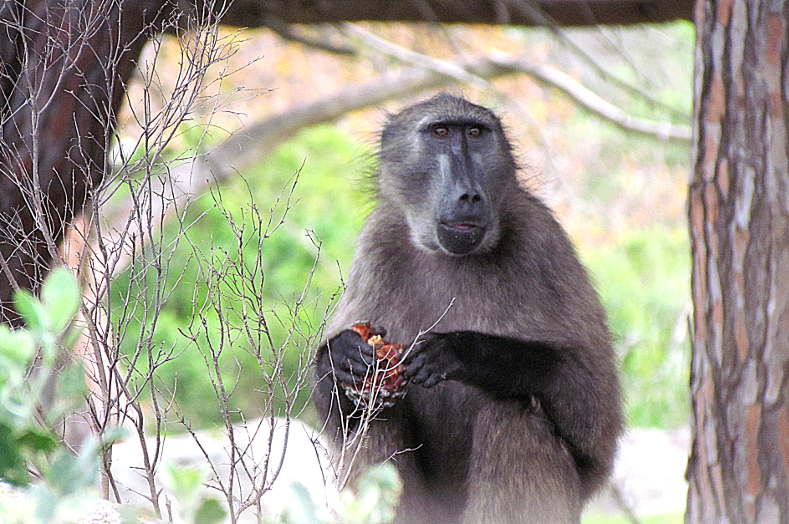
Sub adult male baboon eats pine nuts from a pine cone. While the Da Gama troop often sleeps in the urban area i.e. at the Navy flats or pine trees in Da Gama Park, residents in Welcome Glen have commented on baboons being more in the area during the day in recent months.
Baboons are opportunistic feeders. As such, if they are in the area, they will eat available food, including if found in unsecured houses and bins. Baboons get blamed if they raid, and raiding incidents go on what could be referred to as their "rap sheets". The incidents can count against them when recommended to CapeNature's WAC for culling, particularly if they are already tagged, collared and under watch.
It is the responsibility of the rangers to chase them out the area. They have used paintball guns over the last two years, although this has been a controversial 'tool'. A number of baboons have been culled, as they are said to be pain aversion tool resistant. Previously baboons were moved by monitors using shouts and whistles.
UPDATE - March 2014
Cape Argus Pick 'n Pay, Momentum Cycle tour medals 2013-2014 feature "Our Natural Heritage" - chacma baboons and proteas
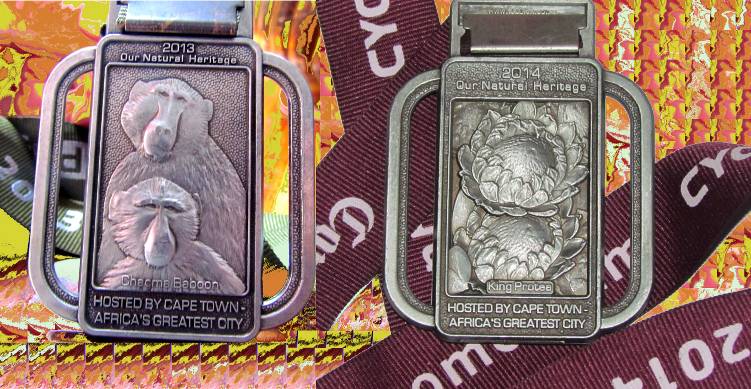
UPDATE - January 2014
Although two out of remaining three Da Gama adult males die in 2013, the three maturing Da Gama Park male baboons targeted by culling
DG9 Naughty Boy culled 22nd January 2014, one of several young adult males to be culled in the Da Gama Park troop. At least 17 Peninsula baboons were culled in 2013 in terms of controversial raiding protocols.
DG9 called Naughty Boy was yet another baboon culled in terms of the raiding protocols. The photographs of him above, and in the November/December update were taken in December. He was culled on 22 January, 2014.
At least 18 baboons were culled in 2013.
It is officially denied they are 'culled' - instead the word 'euthanased' is used, although the baboons are often young, healthy or alpha males fulfilling a vital role in the troop.
As the picture in the update shows DG9 is sitting with guinea fowl and pigeons fed on the pavement by a resident even though this practice is discouraged as it is an attractant for baboons.
Yet when baboons eat human derived food in the urban area these incidents are recorded and count against them when their case histories are submitted for consideration for culling to Capenature. Killed in terms of controversial protocols, baboons pay the price even though people may have failed to or refused to baboon proof properties or bins.
A companion of DG9 is DG10 or Eddy.
Permission has also been granted for Eddy to be culled.
Calvin, Naughty Boy, Eddy, three of the Da Gama young males maturing into adults able to protect the young and the troop, have been targeted for culling - even though this troop lacks adult males.
When the troop was left with only one adult male in 2013 due to the death and culling of two of the three adult males, a male from a neighbouring troop entered and killed all 10 infants and a juvenile.
Killing these three young males, could again render the troop subject to negative knock on effects that affect other individuals and the well being of the entire troop.
DG9 Naughty Boy culled in January 2014 under raiding protocols sits with guinea fowl and pigeons on pavement strewn with bird seed, an attractant for baboons.
From the November/December update "Under current protocols, baboons can be targeted for coming into the urban area and 'raiding' or eating available human derived food.
Raiding incidents are recorded and used as evidence when motivating for culling in terms of the protocol to reduce the frequency and severity of raiding behaviour or the dispersing male and repeat raiders protocol. "
UPDATE - November/December 2013
The current approach to baboon management is pain aversion tools and killing raiding baboons - but should these controversial strategies continue into 2014 or come under independent review?
|
|
UPDATE - October 2013
Calvin was culled in early October, Da Gama troop adult and maturing males increasingly depleted
Calvin on 30 September, shortly before being killed, seen digging in soil for clover bulbs.
The decision was taken to now refer to the main and fission troop as the Da Gama troop given they have been in the same vicinity for the last three months.
The combined troop now consists of 42, down from 54 at the end of 2012 for both troops. Yet, baboons from this troop continue to be culled, Calvin being one of the latest.
Previously Horace, alpha male of the fission troop has been referred to by some HWS staff as the alpha male of both troops.
While it is now again claimed that Quondi is an integral part of the troop and is a cohesive force (something one would assume is the attribute of an alpha male). there are also claims that he broke windows to gain access and that he enters town to raid.
Incidents of baboons who have been accused of deliberately damaging property to gain entrance seem very high since August 2012.
Breaking into a property, entering a property or vehicle to look for food if people are in that property count heavily against a baboon when recommended for culling in terms of raiding protocols.
Some residents when thought to be opposed to paintballing or culling of baboons or supportive of the humane treatment of the baboons have been falsely accused of purposefully feeding baboons.
Residents who are strongly opposed to baboons in the urban area may also falsely report other residents of feeding and thereby attracting baboons into the neighbourhood. Ironically, if they fail to baboon proof, they themselves attract baboons onto their properties.
With false allegations not uncommon relating to the baboon situation, it has raised the question if there is a possibility that spurious allegations do not also occur against the baboons.
Baboons' case histories are compiled for submission to CapeNature for consideration.
CapeNature's Wildlife Advisory Committee or WAC gives permission for baboons to be killed. It has no direct dealings with the baboons. It is reliant on the information submitted to it via officials or residents' statements.
When the 2nd protocol of June 2010 was introduced, despite requests for a year it was not made available to the public, one official stating the reason was it could be "used against the baboons".
William, originally from the Da Gama Park troop, who after dispersal, in time became alpha of the Scarborough troop, was the first baboon killed under its terms. (Residents who saw him being cage trapped for lethal darting were told his collar batteries were being changed.)
One of the two statements given by residents against William used as evidence against him in his case history came from a person who was out the country much of the time.
Calvin in August 2013, after Horace had begun fighting with him and he had begun to leave the troop at times to avoid injuries.
Although the troop is already short of mature males, Calvin, a young male of the Da Gama troop approaching maturity was culled in early October 2013.
At the end of June 2013, the Da Gama main troop was pushed back to Da Gama Park where the fission troop was.
Horace, a male from the neighbouring Slangkop troop had become alpha of the fission troop. It consisted of adult females and young after the culling of Peter and Carpenter in an attempt to remove the fission troop.
Removal of fission troops reflected a proposal first made at the baboon expert workshop in 2009 in a presentation by the head of BRU entitled "Reducing numbers".
The main troop returned with only one mature adult, alpha Quondi, (Quizzy was attacked by humans and dogs on 14 March, then put down. Mavula was culled shortly thereafter because he was raiding and deemed resistant to pain aversion tools.)
People who get to see the troop since its return invariably comment the adult juvenile ratio appears skewed, with too few adults. While away adult females had also died, been culled, or disappeared.
Calvin was being chased and injured by Horace and so began to sleep apart from the troop at times, also during the day leaving the troop on occasions, sometimes joined by a few others.
Baboons leaving the troop may present problems for the service provider, splitting personnel. It may also make it appear as though rangers are not properly doing their job or that tools such as paintballing are not effective.
As a dispersing male, regularly leaving the troop on exploratory trips to find a new troop and starting to establish relationships from the outskirts to facilitate acceptance would be considered normal behaviour.
Yet under current conditions, if a male tries to find a new troop, he is often likely to be killed under the dispersing male or raiders protocols.
In the case of the south Peninsula troops in particular, it is still possible for males to disperse to other troops if allowed eg Slangkop to Da Gama Park.
The fact remains, the scientific input that has led to the introduction of aggressive tools and management strategies like culling has been in dire need of independent review from the time it was publically suggested in July 2009 and soon thereafter began to be implemented.
2013 follows years (August 2009-June 2012) of holding the line on the urban edge, which allowed baboons to come into the urban area and raid unsecured properties during the day, rather than being herded away to forage in the hills, frustrating residents who failed to baboon-proof.
There has now been more than a year of paintballing, the head of BRU's short term solution, with baboons continuing to be culled for raiding and more male baboons becoming resistant to pain aversion tools - then culled.
Current scientific input is long overdue for review - before possible implementation of the head of BRU's proposed long term, but once again controversial solution, of electric fences around baboon affected areas.
Electric fencing is currently being promoted in public meetings in areas like Scarborough and Kommetjie.
|
|
|
||||||||||||||||||||||||
|
||||||||||||||
